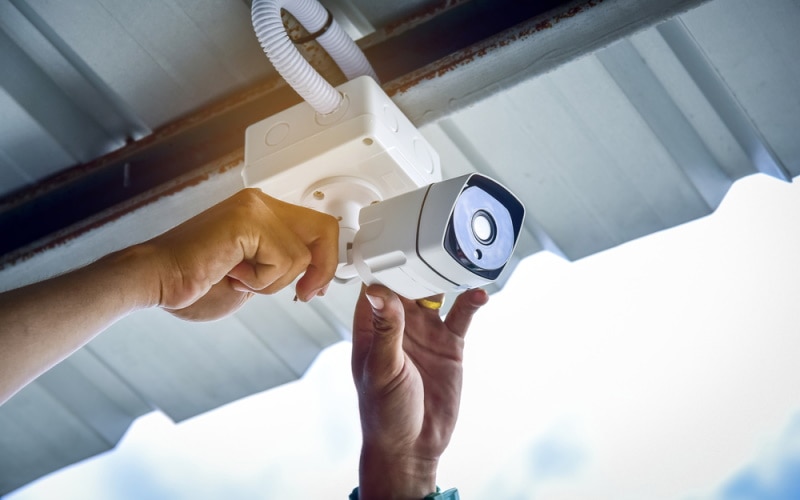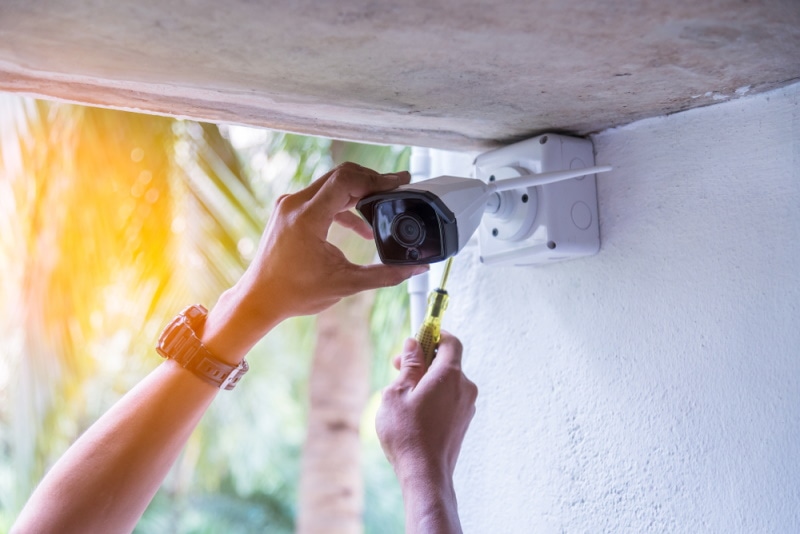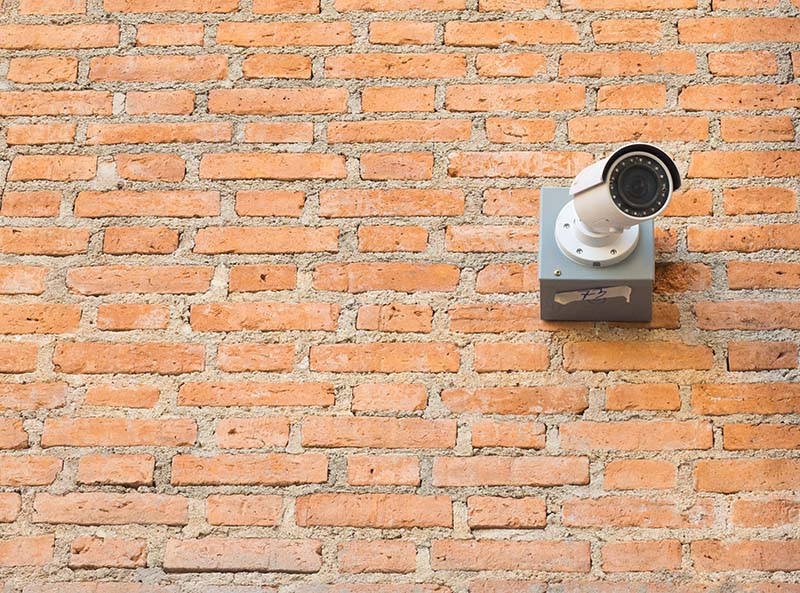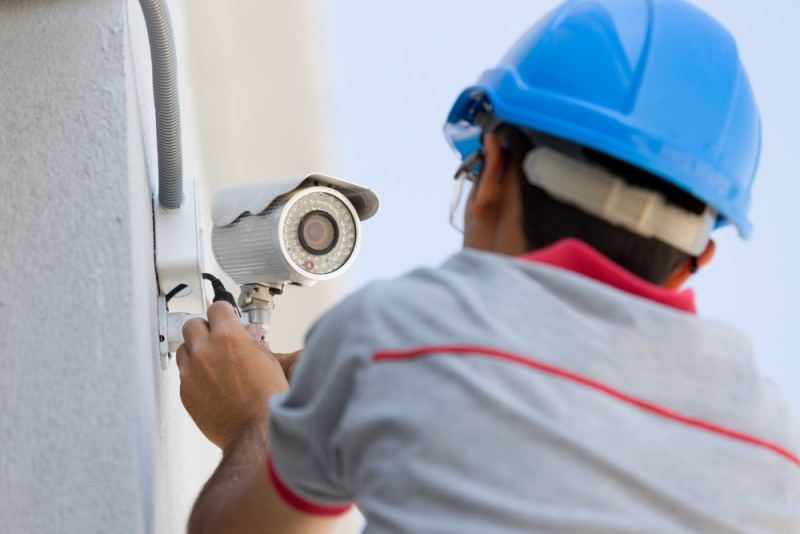How to Install Home Security Cameras – 12 Tips and Tricks
-

- Last updated:

Are you prepared to take your home security to the next level? Installing a camera system may sound intimidating, but we have excellent news for you—it doesn’t have to be that way!
Thanks to our 12 helpful tips and tricks, you can install your cameras like a pro. Let us guide you through this process, and watch your home become more secure in no time!

The 12 Tips to Install Home Security Cameras
1. Invest in the Right Type of Cameras

Before you make a home security camera purchase, it’s essential to gain an understanding of both your requirements and the different kinds of cameras that are available. Unfortunately, many folks fall into the trap of immediately opting for any type without first examining which will be most suitable for them.
Consequently, take time to carefully assess all possibilities so that you can pick out precisely what works best in your situation. Here are some popular options:
Indoor Cameras: These cameras are usually smaller and designed to be mounted inside. You can usually find models with features like night vision, motion detection, and two-way audio.
Outdoor Cameras: Outdoor cameras are larger and designed to be mounted outside your home. They are often weatherproof and have features like night vision.
Wireless Cameras: These cameras use Wi-Fi to connect to your home network. Although they’re often more expensive, wireless cameras offer the convenience of being able to install them anywhere.
To ensure you have the utmost protection of your property, consider installing one or all three kinds of cameras. Take some time to explore what choices are available and decide which will be most suitable for your needs.
2. Choose the Right Location
When selecting the best cameras for your home security, you’ll need to decide on where they should be placed. As a rule of thumb, locations with unobstructed views and good visibility of your property are ideal spots.
Additionally, it’s essential that you consider how the sun’s direction could affect their recordings since this could result in distorted pictures.
Further still, ensure that all cameras are installed at an angle to capture a wider view around your area, and also make sure to install them out of reach from any potential tampering or interference.
3. Prepare the Installation Area

Prior to installing your surveillance cameras, you should always set up the area first. Not only will this make setup easier and faster, but it’ll also guarantee that everything is secure and sound.
If you have exterior cameras in use for your security network, be sure to cut away any vegetation or objects which could block its view.
As far as indoor camera positioning goes, take out pieces of furniture or decorative items that may potentially obstruct what the camera sees. Taking these precautions beforehand guarantees flawless surveillance with no visual disturbances!
4. Connect Your Cameras
Now that you’ve prepped the setup area, it’s time to hook up your cameras. To begin, attach them to a power source such as an AC outlet. If they are wireless cameras, link them to your home network and adjust the settings in accordance with the user manual guides.
For wired cameras, use a PoE (Power over Ethernet) adapter for simultaneous supply of power and data transmission through one cable connection only.
Once done connecting all the cams, mount them on specific locations using screws and anchors compatible with the surface material type.
5. Test Your System

The most critical component of your setup is now at hand—testing! Make sure to inspect the resolution and coverage range from each camera to guarantee everything functions properly. The motion detection feature on your cameras can also be taken advantage of as you test their sensitivity. If all checks out, congratulations; your security camera installation is complete!
6. Don’t Use Indoor Cameras Outdoors
If you’re unfamiliar with the nuances between outdoor and indoor cameras, it’s certainly understandable if you get the two types confused. However, these subtle differences can have a significant impact on your setup if not taken into consideration.
Specifically, while indoor cameras are best suited for interior settings, they may not be able to tolerate more extreme external elements such as weather conditions or temperatures. Outdoor cameras have been tailored with these factors in mind, so make sure that whatever camera you purchase is compatible with its intended environment!
7. Place Security Cameras Higher Up

When configuring security cameras, it is wise to mount them at an elevated position. This is because the farther off the ground they are, the wider their range will be, and if they’re outside, then there’s a lesser chance of them being damaged or stolen.
To ensure that you don’t miss any potential threats on your property, maximize the height of where you install your cameras—it could make all the difference between spotting a burglary in progress and missing it entirely!
8. Use Recording Devices to Store Footage
To maximize the security of your home or business with surveillance cameras, you must also have a recording device. An external hard drive or an NVR (Network Video Recorder) are both excellent options and will allow you to access footage from anywhere at any time. With this setup, all video captured by the system can be stored for later viewing when needed most.
9. Hide Your Cables

Securing your property is essential, and one of the most effective ways to do so is by concealing cables. Not only does this make for a more aesthetically pleasing home, but it also eliminates any potential security threats.
To make sure that all wires are hidden away from sight, consider storing them in areas like attics or basements. On the other hand, if you opt for wireless cameras, there’s no need to worry as they don’t require wiring at all!
10. Pay Attention to Placement
Paying close attention to where you place your cameras is just as crucial as the type of camera itself. Make sure each security camera has a clear view of the area it observes, and its angles are adjusted accordingly. Doing this will ensure that any suspicious activity won’t be missed by your surveillance system!
11. Consider Your Sight Lines

When placing your cameras, consider their field of view and confirm that nothing will block the camera’s vision. Using a laser point or other item may help test your device’s range to ensure it can catch all you need. This way, you have complete confidence in what your cameras are able to see!
12. Secure Your Cameras
Lastly, ensure that your cameras are anchored tightly in place and cannot be ripped off easily by criminals. Furthermore, guard the security footage of your camera system with a password to guarantee its safety even if someone manages to access it. Additionally, store these passwords somewhere safe for added protection.

Conclusion
With this step-by-step guide, you now have the knowledge to properly install home security cameras and protect your property from potential threats. From selecting the right type of camera to securing its placement, these 12 tips are sure to provide a greater sense of safety in any household.
With this newfound confidence in installing home security cameras, you can rest easy knowing your family’s well-being is protected!
Featured Image Credit: APChanel, Shutterstock
Contents
